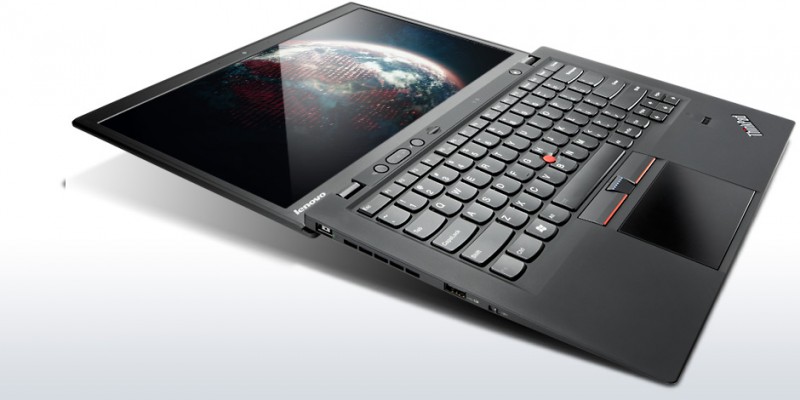I’m often asked by friends what laptop they should buy. As my home system is designed around Apple devices, those friends are surprised when I almost always answer, “Lenovo.” My first laptop was a ThinkPad 380. In the almost 20 years that I’ve been using and repairing laptops, I’ve always found the Thinkpad line to be of the highest quality and best value. I’m throwing that out there so everyone is clear that I may be slightly biased.

You never forget your first brick.
Lenovo was an early member of Intel’s high-end Ultrabook initiative. The goal was to create high-end, lightweight notebooks that could challenge Apple’s dominant ultralight, the MacBook Air. Except Intel was sort of late to the party, because Lenovo has been one of the few companies directly targeting the Air, most strongly with their X series. Who can forget the brilliant ad for the Lenovo ThinkPad X300, challenging Apple’s images of a MacBook Air as easy enough to store in an envelope?
[yframe url=’http://www.youtube.com/watch?v=_hnOCUkbix0′]
Lenovo’s previous Ultrabook entries have been part of the more consumer-oriented IdeaPad line. Recently, however, the company announced it would bring the Ultrabook style to the venerable business-class ThinkPad family. While the ThinkPad T430u is pending release, I was given a chance to review the slightly-cooler named ThinkPad X1 Carbon. Because I miss my X31, I jumped at the chance. But is the X1 a worthy successor to the previous generations of Lenovo ultralights?
First Impressions
One thing I can’t help but notice when I look at other companies’ Ultrabooks is that they look the same. They all ape Apple’s metallic look at the bare minimum and sometimes go a bit closer. Lenovo, however, chooses to stay with the company’s signature black body, thinning it out a bit. While this choice may seem dull to some, it actually has the impact of making the X1 Carbon stand out in a sea of silver. Another standout feature is the carbon nano-fiber body (hence the name). The body feels a bit rubbery to the touch at first , but it also feels a lot less slick or hot than metal-encased Ultrabooks. X1 is less of a fingerprint magnet.

All X1 photos are from Lenovo, unless specifically stated. Because I am a crap photographer, that’s why.
The (deliciously backlit) keyboard is different from the traditional, well-loved ThinkPad keyboard. Thinkpad devotees will recognize the standard pointing mouse, plus a large trackpad option. I usually eschew trackpads when there’s a pointing stick, but this big boy is actually tempting. Lenovo has thrown in a fingerprint-reader, which is standard these days, as well.

I don’t care if I personally have no use for a fingerprint reader – they’re just cool.
The right side gives you a 4-in-1 media reader, combination headphone/microphone jack, Mini DP port for video out, USB 3 port, and security port.
The left side has a WiFi toggle, second USB 3 port, fan exhaust, and DC in. Carbon’s DC in port looks kind of like some sort of data port. I have to say, I rather like it.
The back has a surprise for you in the addition of a SIM slot. Useful for those who want 3G data on the go.
X1 comes with a 14″ anti-glare screen with a 1600 x 900 resolution. While the X1’s screen is no MacBook Pro with Retina display, it’s great to use, especially with the anti-glare coating. More computer manufacturers need to make glare prevention a serious priority. Atop the screen you’ll find the 720p webcam.

I don’t know if HD webcams are a killer app, but they’re expected by now.
The Software
I assume the X1 will eventually come loaded with Windows 8, but for now, it runs Windows 7 Professional. There are no issues with the OS, and I’d be shocked if there had been. What I do have an issue with, however, is that Lenovo threw an insane amount of software on to the X1. Sure, some are apps that most would have downloaded anyway (Adobe Reader, Skype, and Google Chrome). Others, however, feel like bloat. There’s a Lenovo Appshop, Lenovo Cloud Storage by SugarSync, Lenovo ThinkVantage tools, UltraPro PDF maker trial (which is also your default PDF reader, so why bother with Adobe?), Splashtop Remote/Streamer (a good value, but a distinctly specialized tool), Verisign VIP, a bunch of Intel tools that I suspect come with every UltraBook, MS Office 2010 trial, Absolute Data Protect, and Evernote.
One particularly odd bit of bundleware has to be SimpleTap. Essentially an additional user interface layer over Windows 7, I genuinely can’t think of any reason for this to exist. This software is going to be crazy redundant when Windows 8 comes out.
For those worried about viruses, Lenovo has bundled in Norton Security. Pardon me, but ew. In the era of free, low-footprint security apps like AVG Free or Microsoft Security Essentials, this is needless bloat. Worse, it’s nagware in that it’s always reminding you to register/update. A good AV should be invisible.
If this unit was a keeper instead of a loaner, my first step would’ve been to format the drive and install Windows 7 all over again without all the bloat.



Comments are closed.